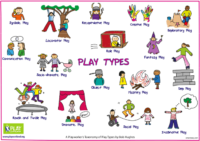Play types can simply be described as the different behaviours that adults can observe when children are playing.
There have been numerous attempts to categorise different types of play, the most often used are Bob Hughes’ Play Types from his 1996 book A Playworker’s Taxonomy of Play Types.
It is important to be able to recognise the different types of play in order to:
- Understand the power of different kinds of play and the benefits of different kinds of play
- To monitor the types of play already happening
- To ensure to support and extent different kinds of play so all children have wide-ranging high-quality play experiences as engaging in each play type is necessary for a child’s healthy development
Watch our video explaining the Play Types
Grouping the Play Types
To better remember and understand Bob Hughes’ Play Types, we have grouped the different types of play together under useful learning headers:
Learning About The Physical World
Creative Play
Play which allows a new response, the transformation of information, awareness of new connections, with an element of surprise.
This play type is one of the most visual by allowing a child to access loose parts, arts and craft materials.
Exploratory Play
Play to access factual information consisting of manipulative behaviours such as handling, throwing, banging or mouthing objects.
Mastery Play
Control of the physical and affective ingredients of the environments, for example making a dam in a stream, building a bonfire and digging holes in the earth or sand.
Object Play
Play which uses infinite and interesting sequences of hand-eye manipulations and movements i.e. examining an item and looking into how and why something works.
Learning About Myself and How to Be in the World
Communication Play
Play using words, nuances or gestures for example, mime, jokes, play acting, mickey taking, singing, debate, poetry. Communication play used the whole body – from facial expressions, hand gestures, body demonstrating and vocally.
Dramatic Play
Play which dramatizes events in which the child is not a direct participator.
Children may also wish to use make up and costumes in this type of play.
Role Play
Play exploring ways of being, although not normally of an intense personal, social, domestic or interpersonal nature. This could be a child pretending to be driving a car, ironing, piloting a plane.
Social Play
Play during which the rules and criteria for social engagement and interaction can be revealed, explored and amended. This could be playing a game together, building an item together or creating something together.
Socio-dramatic Play
The enactment of real and potential experiences of an intense personal, social, domestic or interpersonal nature. This could be playing at mums and dads, or playing house.
Learning About My Body and Limits
Locomotor Play
Movement in any or every direction for its own sake, for example playing chase, jumping, skipping and climbing trees.
Rough and Tumble Play
Close encounter play which is less to do with fighting and more to do with touching, tickling, gauging relative strength. Discovering physical flexibility and the exhilaration of display. This will not involve any deliberate hurting but children should be laughing and having fun.
Learning About What it is to be Human
Deep Play
Play which allows the child to encounter risky or even potentially life threatening experiences, to develop survival skills and conquer fear.
This type of play is defined by play behaviour that can also be classed as risky or adventurous. This has important benefits to a child’s development.
Fantasy Play
Play which rearranges the world in the child’s way, a way which is unlikely to occur, for example being a superhero or sitting on a cloud.
Imaginative Play
Play where the conventional rules, which govern the physical world, do not apply, for example pretending to be an animal, or having a make-believe friend to being an object i.e. a tree.
Recapitulative Play
Play that allows the child to explore ancestry, history, rituals, stories, rhymes, fire and darkness. Enables children to access play of earlier human evolutionary stages.
Symbolic Play
Play which allows control, gradual exploration and increased understanding without the risk of being out of one’s depth. Example a stick becomes a sword or light saber a flower becomes a wand.
Play Types to Support Learning
“There is no better activity for learning and development than play”.
(Doherty and Hughes, 2014:176)
The Play Types Toolkit is intended for schools and education professionals but can also be useful fo practitioners in other settings.
The aim is to highlight the range of types of play children experience, their vital contribution to learning and development, and to make integration of play into the curriculum simpler.





